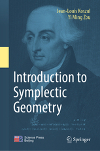- About MAA
- Membership
- MAA Publications
- Periodicals
- Blogs
- MAA Book Series
- MAA Press (an imprint of the AMS)
- MAA Notes
- MAA Reviews
- Mathematical Communication
- Information for Libraries
- Author Resources
- Advertise with MAA
- Meetings
- Competitions
- Programs
- Communities
- MAA Sections
- SIGMAA
- MAA Connect
- Students
- MAA Awards
- Awards Booklets
- Writing Awards
- Teaching Awards
- Service Awards
- Research Awards
- Lecture Awards
- Putnam Competition Individual and Team Winners
- D. E. Shaw Group AMC 8 Awards & Certificates
- Maryam Mirzakhani AMC 10 A Awards & Certificates
- Two Sigma AMC 10 B Awards & Certificates
- Jane Street AMC 12 A Awards & Certificates
- Akamai AMC 12 B Awards & Certificates
- High School Teachers
- News
You are here
Introduction to Symplectic Geometry

Publisher:
Springer
Publication Date:
2019
Number of Pages:
121
Format:
Hardcover
Price:
74.99
ISBN:
978-981-13-3986-8
Category:
Monograph
[Reviewed by , on ]
Bill Satzer
08/4/2019
Symplectic geometry is a branch of differential geometry that studies even-dimensional manifolds whose structure is determined by a distinguished closed non-degenerate two-form. (The cotangent bundle of a manifold is a canonical example.) Its history begins with Lagrange who developed the idea in the course of investigating the dynamics of planets in the solar system.
Since Lagrange, the subject has grown a great deal, first in the study of Hamiltonian systems where the two-form-preserving property of symplectic mappings is important. Later, applications to Lie theory, geometric quantization, harmonic analysis and microlocal analysis followed. About 1985, with the work of Gromov and Hofer, the scope expanded once again with the introduction of J-holomorphic curves, the analog to geodesics in Riemannian geometry. Applications of symplectic geometry now range from differential equations and dynamical systems to algebraic geometry, topology, representations of Lie groups, mathematical physics and more.
The current book originated with lectures given by Koszul in China in 1983, written and translated by Zou. A book based on these was prepared and published in 1986 in Chinese, but not translated until 2013. The story of the recovery, background and translation is told in the book’s three forewords.
Koszul’s treatment of symplectic geometry emphasizes the algebraic and differential geometric aspects of the theory. His work as presented here continues and reinforces the pioneering work of Jean-Marie Souriau who developed many of the early aspects of symplectic geometry dealing with group actions in the context of classical and quantum mechanics and thermodynamics. Koszul’s book offers a different perspective, some new proofs, and new ideas.
The first three of the book’s six chapters introduce the algebraic background of the symplectic form, the basic topology of symplectic manifolds, and the structure of cotangent bundles. In the fourth chapter, Koszul describes what he calls a symplectic G-space: a symplectic manifold M together with the actions of a Lie group G. From there he goes on to consider the Hamiltonian version of this (with the Lie algebra of G acting on M to produce Hamiltonian vector fields). Souriau’s moment map is described in this context; it is a tool used to construct conserved quantities for a Hamiltonian group action. In Hamiltonian mechanics these include conserved linear momentum arising from the translational symmetry group and conserved angular moment associated with the action of the rotation group.
Poisson manifolds and supermanifolds are discussed in the final two chapters. A Poisson manifold is a generalization of a symplectic manifold that can be regarded as a manifold with a smooth foliation in which each leaf is a symplectic manifold. A supermanifold is a yet more abstract object that was originally motivated by ideas of supersymmetry in quantum physics. Very roughly, a supermanifold can be thought of as a manifold with “superpoints” which consist of spatial coordinates in ordinary n-dimensional space (the base manifold) and a pair of Grassmann algebra coordinates. Koszul looks mostly at the special case where the spatial component is just the origin. From this he goes on to a formulation of symplectic supermanifolds.
Although many of the concepts he describes had origins in physics, Koszul’s approach throughout this short book takes a step back to understand the structures first algebraically and secondarily in the language of differential geometry.
This is not a textbook and has no exercises. Prospective readers would need a graduate level background in algebra and differential geometry, with at least some knowledge of Lie theory. This would not be an ideal introduction to the subject; it is idiosyncratic and has too little detail and no examples. Better sources for an introduction might be Introduction to Symplectic Topology by McDuff and Salamon, or Arnóld’s Mathematical Methods of Classical Mechanics, which approaches the subject through the lens of Hamiltonian mechanics.
Bill Satzer (bsatzer@gmail.com) was a senior intellectual property scientist at 3M Company. His training is in dynmaical systems and particularly celestial mechanics; his current interests are broadly in applied mathematics and the teaching of mathematics.
See the publisher's web page.
- Log in to post comments




